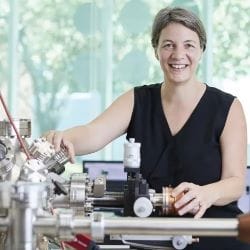

Silicon Quantum Computing (SQC), an Australian startup company with state-of-the-art research and atomic manufacturing facilities in Sydney, founded by Society Distinguished Fellow, Scientia Professor Michelle Simmons AO FRS DistFRSN FAA of UNSW Sydney, has just announced the world’s first integrated circuit at the atomic scale. This technical breakthrough announced at UNSW on 23 June 2022 and published in Nature described the chaining together of 10 quantum dots to create a quantum integrated circuit capable of simulating molecular behaviour — validated by simulating the structure and energy states of the organic compound polyacetylene.
SQC is a startup company, founded in 2017 with $83 million of capital from the Australian and NSW State Governments, UNSW Sydney, the Commonwealth Bank and Telstra, and built on the intellectual property developed by the ARC Centre of Excellence for Quantum Computational and Communication Technology led by Professor Simmons, the 2018 Australian of the Year. The development, which comes two years ahead of schedule for SQC and a decade after the ARC Centre’s development of the world’s first single-atom transistor, delivers on a challenge first set by pioneering theoretical physicist and Nobel Laureate, Professor Richard Feynman, who asserted the possibility of the direct manipulation of atoms, as a more robust form of synthetic chemistry, in his famous 1959 lecture, Plenty of Room at the Bottom.
The SQC analogue quantum processor was built using a scanning tunnelling microscope to precisely place multiple atomic components within a single device. Amongst the technological feats underpinning this breakthrough were the ability to create sufficiently small quantum dots of uniform size, allowing their energy levels to align to let electrons pass easily through them, and the ability to tune the energy level for each dot individually, and collectively, to control the passage of quantum information.
Speaking at the launch, which was attended by Mr Ed Husic MP, Minister for Industry and Science, Professor Simmons described the development as the biggest result of her career. “This has never been done before and nobody else in the world can do it,” Prof Simmons said. “It is a hugely exciting result and what is even more exciting for us is having done that, we have seen that classical roadmap and that we know the commercial devices that are within the next five or six years.”